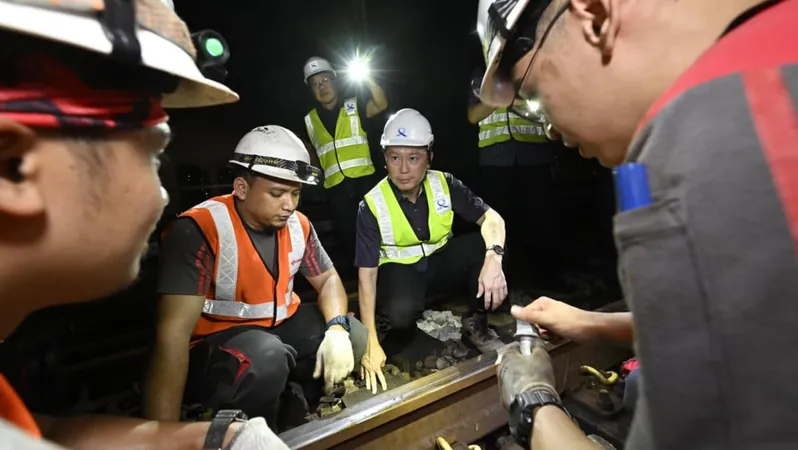
Hubble's Groundbreaking Discovery: Black Hole Jets Triggering Stellar Explosions Like Never Before!
2024-09-26
Hubble's Groundbreaking Discovery: Black Hole Jets Triggering Stellar Explosions Like Never Before!
In an astonishing revelation, astronomers using NASA's Hubble Space Telescope have found that powerful jets launched by a supermassive black hole can significantly increase the frequency of nova explosions in its vicinity. Lead author Alec Lessing from Stanford University expressed the excitement surrounding this unexpected finding, stating, “We don't know what's going on, but it's just a very exciting finding. This indicates there’s something missing from our understanding of how black hole jets interact with their surroundings.”
Understanding Nova Explosions
To understand this phenomenon, let's delve into the mechanics of a nova. A nova occurs in a binary star system, where an aging star spills hydrogen onto a white dwarf, which is the remnant of a star that has exhausted its nuclear fuel. Once the white dwarf accumulates enough hydrogen, it experiences a cataclysmic explosion, temporarily brightening massively before returning to siphon more fuel from its partner star, restarting the cycle.
Hubble's Astonishing Findings
Hubble's observations revealed a surprising statistic: it discovered twice as many novae erupting near the jets of the central black hole in the giant galaxy M87 compared to other regions. This 6.5-billion-solar-mass black hole is surrounded by a swirling disk of material that fuels its voracious appetite and generates a breathtaking jet of plasma extending 3,000 light-years across, moving at nearly the speed of light. While this beam can incinerate anything in its path, the new findings indicate that the area around the jet is also dangerously stimulating the formation of novas.
Proposed Mechanisms for Increased Nova Activity
The research suggests that either there are double the number of binary star systems near the jet or that these systems experience nova eruptions at twice the rate compared to the rest of the galaxy. Lessing proposed a hypothesis: “Perhaps the jet is snowplowing hydrogen towards the white dwarfs, leading to more frequent eruptions. It might also be the pressure from the jet’s light that accelerates the mass transfer rate onto the white dwarfs nearby.”
Alternative Explanations Explored
Despite this intriguing theory, other ideas about the mechanism at play were explored; for instance, whether the jet heats the companion star enough to increase hydrogen spillover onto the dwarf. However, calculations indicated that this heating alone would be insufficient to account for the observed increase in nova activity.
Confirming Previous Observations
The findings echo prior suspicions regarding increased astrological activity near the M87 jet, but Hubble has provided definitive evidence with a more statistically significant dataset than ever before. Early observations, made shortly after Hubble's launch in 1990, pointed to unusual transient events near the black hole. However, researchers struggled to categorize these phenomena until new imaging techniques were developed.
New Imaging Techniques and Findings
Over nine months, Hubble captured new, detailed images of the M87 region, confirming the hypothesis that the black hole’s jets were influencing the stellar activity surrounding it. A total of 94 novas were detected, with an evident concentration along the jet path—an observation that was visually striking even before rigorous statistical analysis was applied.
Expert Opinions on the Discovery
Chiara Circosta, an ESA Research Fellow, expressed her surprise at these findings, emphasizing their importance in expanding our understanding of galaxy evolution and the interactions between supermassive black holes and their host galaxies.
Hubble's Unmatched Capabilities
Hubble's capabilities are unmatched, allowing astronomers to observe novae that are otherwise lost in the bright background of M87’s core, something ground-based telescopes simply cannot do. Remarkably, intrigues of the cosmos unveil that novae are incredibly common; approximately one nova erupts in M87 daily, and given there are around 100 billion galaxies in the observable universe, estimates predict a staggering 1 million novas erupting somewhere in the cosmos every second.
Conclusion and Future Research
This monumental discovery isn’t just another chapter in a textbook; it is a thrilling journey into the mysteries of the universe. Is it possible that black holes, often viewed as monstrous entities of destruction, also play a pivotal role in the creation of new stars? Stay tuned for further revelations as researchers deepen their inquiry into the cosmic ballet performed by black holes and their surroundings!

 Brasil (PT)
Brasil (PT)
 Canada (EN)
Canada (EN)
 Chile (ES)
Chile (ES)
 España (ES)
España (ES)
 France (FR)
France (FR)
 Hong Kong (EN)
Hong Kong (EN)
 Italia (IT)
Italia (IT)
 日本 (JA)
日本 (JA)
 Magyarország (HU)
Magyarország (HU)
 Norge (NO)
Norge (NO)
 Polska (PL)
Polska (PL)
 Schweiz (DE)
Schweiz (DE)
 Singapore (EN)
Singapore (EN)
 Sverige (SV)
Sverige (SV)
 Suomi (FI)
Suomi (FI)
 Türkiye (TR)
Türkiye (TR)